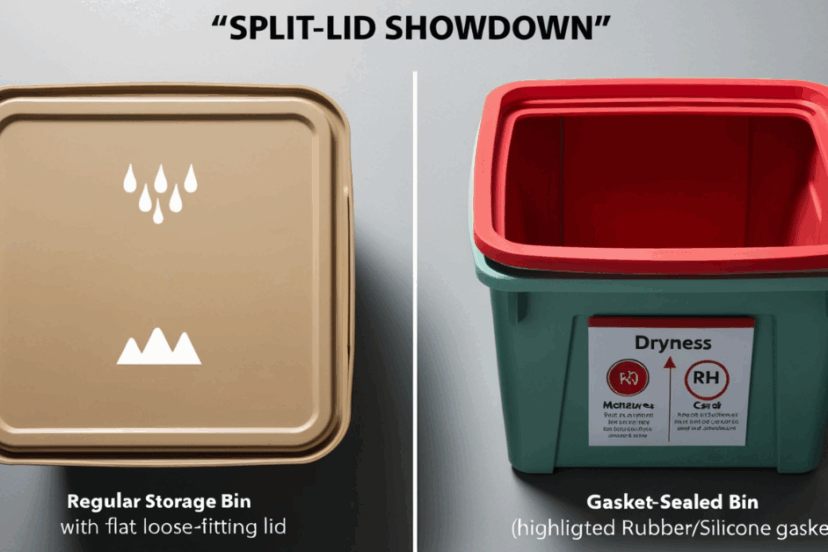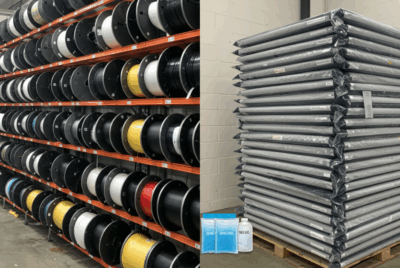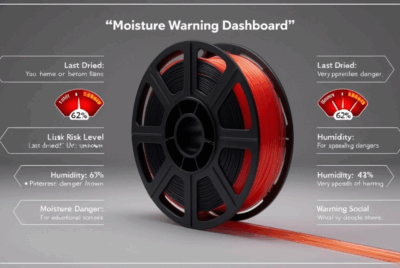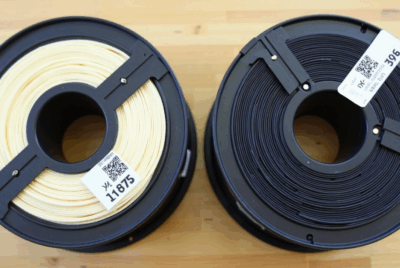What’s the difference between gasket-sealed and regular lids?
1. Why Lid Type Actually Matters
Filament storage isn’t just about the container—it’s about how well it seals.
That all comes down to one component:
✅ The lid.
So what’s the difference between a gasket-sealed lid and a plain snap-on lid?
And does it really make a difference for your filament?
Let’s find out.
2. What Is a Gasket-Sealed Lid?
A gasket-sealed lid has a rubber or silicone strip (the gasket) built into the edge of the lid. When closed, it compresses tightly against the container edge to create an airtight seal.
🛡️ Think of it like the weather-seal on a car door—no moisture, air, or dust gets in.
3. What Is a Regular Lid?
A regular lid simply snaps or presses into place with no gasket or compression seal.
These are:
- Easier to open/close
- Cheaper to produce
- Often found on general-purpose storage bins
❌ But they’re not designed to block humidity or air.
4. The Main Differences at a Glance
| Feature | Gasket-Sealed Lid | Regular Lid |
|---|---|---|
| Airtight? | ✅ Yes | ❌ No |
| Moisture barrier | ✅ Excellent | ⚠️ Poor |
| Ideal for long-term storage | ✅ Yes | ❌ No |
| Cost | 💰 Slightly higher | 💸 Cheaper |
| Humidity control support | ✅ Works with desiccant | ⚠️ Less effective |
| Recommended for filament | ✅ Strongly | ⚠️ With mods only |
5. Why Gaskets Are a Game-Changer for Filament
Filament is hygroscopic—it absorbs moisture from the air.
Even in low-humidity environments, this can degrade print quality.
Gasket lids create a nearly air-tight chamber, making it easier to:
- Maintain low RH with desiccants
- Prevent moisture seep-in
- Stabilize internal temps
Perfect for long-term filament storage or high-humidity regions.
6. How Regular Lids Can Let You Down
Without a gasket, you’ll experience:
❌ Leaky seams
❌ Fluctuating internal RH
❌ Reduced desiccant efficiency
❌ Dust and airflow exposure
❌ Unreliable long-term protection
Even small air leaks can let in more moisture than you think.
7. Comparing Moisture Resistance: Gasket vs. No Gasket
A quick RH test shows the difference:
| Lid Type | RH Inside (After 24 hrs w/ silica) |
|---|---|
| Gasket-Sealed | 20–30% |
| Regular Lid | 40–60% (or higher in humid rooms) |
Without a gasket, silica gel gets saturated faster, and your filament is at risk.
8. Airflow and Seal Quality
Gasket lids:
- Create a compressive seal with air pressure
- Limit cross-contamination of indoor air
- Let desiccants work efficiently in a closed system
Regular lids:
- Allow airflow around edges
- Can shift slightly when stacked or moved
- Don’t “lock in” the dry environment you need
9. Long-Term Storage Reliability
Planning to store filament for weeks or months?
Gasket-sealed bins maintain consistent RH over time.
With regular lids, you may have to:
- Check RH more often
- Change desiccant more frequently
- Dry filament more often
Better lid = fewer headaches.
10. Stackability and Structural Support
Gasket-sealed bins are often built:
✅ With reinforced lids
✅ For heavy stacking
✅ To withstand pressure from other bins
Regular-lid bins? Not so much. You risk:
❌ Lid popping open
❌ Crushed filament
❌ Uneven stacking
11. Real-Life Filament Failures Caused by Poor Seals
- PLA that absorbed moisture in a plastic tote with a warped lid
- Nylon stored in a snap-lid bin stringing like spaghetti
- Desiccant that turned pink in 2 days because of constant air seepage
- Nozzle clogs from brittle filament in a “sealed” drawer system
All avoidable with a proper seal.
12. How to Identify a True Gasket-Sealed Lid
Look for:
- A visible rubber or silicone strip on the underside of the lid
- A “bounce-back” or compressive resistance when closing
- Latch locks or clamps (not just snap fit)
- Product label that says “airtight” or “weathertight”
Not all bins with handles are airtight. Check before you buy.
13. Can You Upgrade a Regular Lid with a DIY Gasket?
Yes—and it works surprisingly well.
- Use adhesive weatherstripping foam tape
- Line the inside edge of the lid
- Close gently to compress the seal
- Test with a humidity card or flashlight test in a dark room
This turns a cheap bin into a filament-safe vault—for just a few dollars.
14. Best Gasket-Sealed Container Brands for Filament
| Brand | Model | Spool Capacity | Notes |
|---|---|---|---|
| IRIS USA | 30–60 Qt Weathertight | 3–8 spools | Affordable, stackable |
| Sterilite | Gasket Box Series | 4–6 spools | Clear, multiple sizes |
| Komax Biokips | XL Locking Box | 3–5 spools | Premium seal |
| Buddeez | Pet Food Bin | 5–8 spools | Flip-top access + seal |
All work well for filament when paired with desiccant and humidity cards.
15. Final Thoughts: Don’t Let the Lid Ruin the Spool
Your container may look sturdy, clean, and even stackable…
…but if the lid isn’t gasket-sealed, you’re gambling with your filament.
✅ Choose gasket-sealed containers
✅ Or upgrade your lid with a DIY seal
✅ Pair with desiccant and tracking tools
✅ Don’t store valuable filament in leaky boxes
Because the best storage system?
Is one that actually keeps the air out.
❓FAQs
- Are gasket-sealed bins worth the extra cost?
Yes—if you care about long-term filament quality, they’re a smart investment. - Can I use a regular-lid bin if I add desiccant?
Short term, yes. But RH will climb faster without a tight seal. - What size gasket tape should I use for a DIY seal?
¼-inch thick weatherstripping foam works well for most lids. - Do gasket-sealed bins need less desiccant?
They’re more efficient, so desiccant lasts longer—but you still need it! - Can I stack gasket-sealed containers safely?
Yes—most are designed for stacking and maintain their seal under weight.




